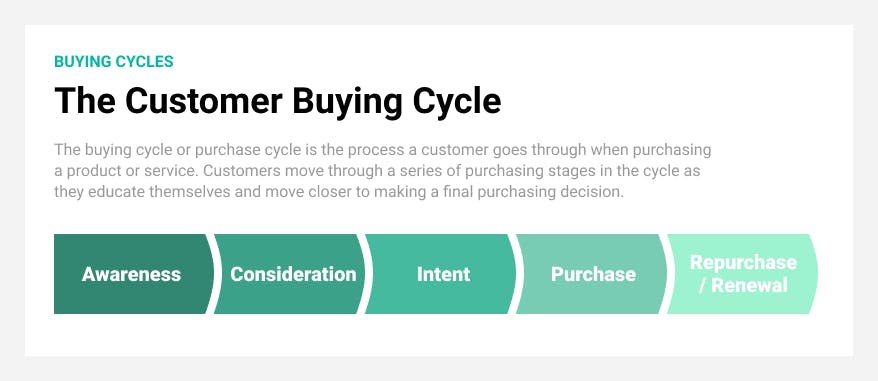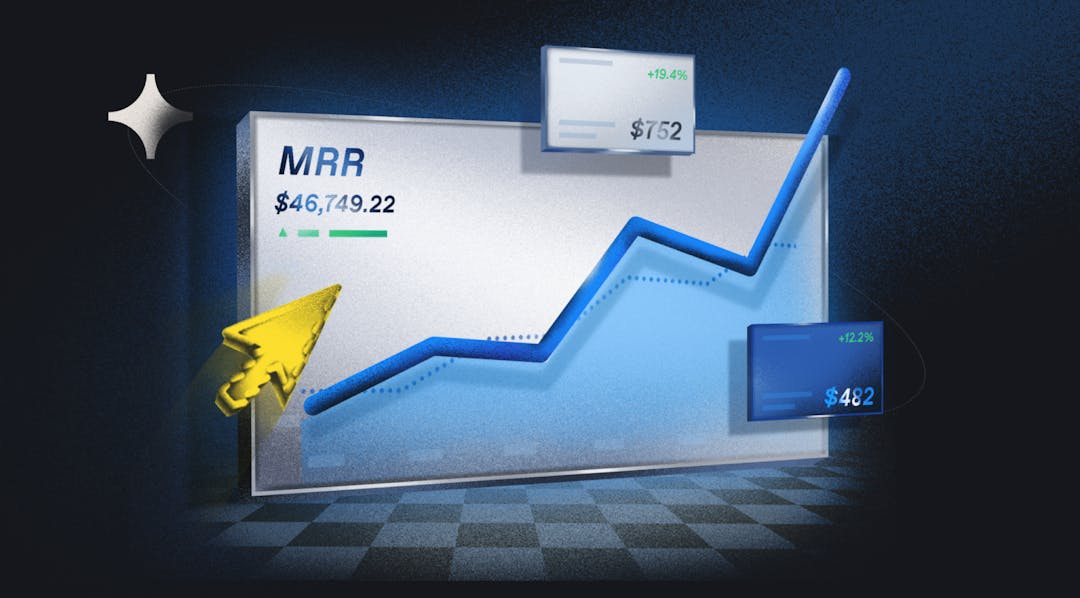It’s not enough to reach people with your marketing. You need a strategy for reaching qualified leads with messaging that’s going to turn them from a passive browser to an active lead. Otherwise, you’ll struggle to make your brand stand out in the B2B SaaS market, in an especially crowded space.
There’s a lot of chatter on the Internet about how to leverage various channels for B2B lead generation. These are often listed as “strategies,” but, in reality, function more like tactics. They might show short-term results, but to sustainably grow your SaaS business, you need to start with the core of your business. In this article, we’ll show you how to develop a strong foundation for lead generation and how to build a strategy that pays off in the long-term.
What is B2B lead generation?
B2B lead generation is essentially customer acquisition. The term refers to the many tactics, channels, and strategies for generating B2B leads, all with the goal of getting high-value customers into your sales funnel.
4 factors that influence B2B lead generation
Before you implement a B2B lead generation strategy, it’s critical to revisit the core elements of your business. All four impact how you frame your pitch and where you go to acquire customers.
1. Market
You won’t know which lead generation channels have the best return on investment unless you’ve done your buyer persona research. Who has problems that your product can solve? Are they in exclusive industries? Do they have certain job titles? Before you do anything else, know your base of potential customers, and understand how they are aligned with your sales funnel.
2. Product
When you’re planning your lead generation campaigns, remember that the primary purpose of your business is to solve a problem. That problem, and the solution you offer, should guide everything else. Your marketing messages should revolve around the solution your product offers. If your product helps people grow their subscription business, talk about topics that will help your leads grow their subscription business, not interesting but irrelevant tech trends.
3. Revenue model
The revenue model you choose for your business will have a major impact on the viability of various B2B lead generation strategies and channels. For example, if you’re offering a freemium model, you may want to focus all your efforts on sign-ups. If you’re using scaled pricing to target different personas, you’ll want to vary your channel and messaging strategies to reach those various personas.
4. Acquisition channels
Lead generation is all about knowing where your customers are and choosing the channels where they’re most likely to engage with your product. Are your customers active LinkedIn users? Are they engaged in Product Hunt or Hacker News? Do they have the time to read ebooks, or do they prefer their content in podcasts? Once you understand your buyer personas, you need to map the channels that are effective in reaching them. This may require a little research and experimentation, but this step will ensure your lead generation marketing is focused and efficient.
3 strategies for effective B2B lead generation
Too often, marketers leap straight into the tactics of lead generation without first making sure they have a solid strategic framework for converting those leads. But lead generation isn’t a surface-level task. If you want sustainable growth, you have to take a holistic approach to generating leads. These three strategies go to the core of your business to form the foundation on which you’ll build your lead generation program.
1. Understand your customers’ buying cycle
It’s your job to tailor your lead generation strategies to your customers’ buying cycle. This step ensures that your marketing reaches the right buyers with the right message at the right time. The key to this is understanding how and when your customers make their purchase decisions.

Source: 5 Buying Cycle Stages: Optimizing Your Buying Cycle Stages and Converting Users
Buying cycles vary between industries, products, and individual customers, but the principles are always the same. Your buyer goes through some variation of:
- realizing they have a problem;
- considering their options;
- making a decision; and
- purchasing a solution (or renewing a subscription).
Design your lead generation campaigns to target each of these stages. For example, you might write educational content on your blog aimed at buyers in the awareness stage but run a pay per click (PPC) ad campaign featuring your best case studies for buyers in the intent stage.
It’s good to leverage top of funnel lead generation channels to nurture leads throughout their buying cycle, but don’t forget—the work of lead generation isn’t done until a lead converts.
2. Offer a compelling value proposition
Now that you understand your customers a bit better, it’s time for them to understand you—specifically, what you have to offer them that your competitors don’t.
Explain this differentiation with a strong value proposition, a statement that communicates the value of your product and promises a solution to customers. Stand out from the crowd of companies looking for B2B leads by following these three guidelines for your value proposition:
- A great value proposition is simple and straightforward. Don’t clutter your core message by trying to convince your customer of everything you’re good at. Your value proposition should answer a single question: What are you great at?
- Listen to your customers. Take what you learned from your buyer persona research and expand upon that knowledge. What does value mean to your customers? Do you and your customers see value the same? If not, revise your value proposition until you align with your customers’ idea of what’s valuable.
- Reinforce your value proposition through repetition, especially across various marketing channels. Come up with a few pithy or concise ways of communicating your value proposition. Work these into your marketing messages to remind buyers why they should choose you.
Once you’ve created a compelling offer to attract leads, it’s time to prepare the final step of turning leads into customers.
3. Optimize pricing
Pricing is the place where your customer knowledge and your value proposition align.
The best way to do this is to follow a value-based pricing model. With value-based pricing, your goal is to figure out how much customers are willing to pay for your product, and then charge them exactly that amount.
Consider using B2B pricing tiers to match different customer needs. Not all your customers will need the features of a $500/month plan, but many customers may buy into $25, $50, and $100 tiers.
So, before you start spending money on lead generation campaigns, make sure your pricing strategy is aligned with your customers. This way, you’re not leaving money on the table, and your leads aren’t turned away by a price tag that disqualifies them as a customer or devalues your product.
The top 9 B2B lead generation channels
You’ve built a solid foundation for attracting and converting your leads. Now it’s time to go out there and find those leads—or more accurately, help those leads find you. The specific mix of channels you choose and the strategies you employ in each one will vary based on your audience and goals. With that said, these nine channel suggestions should provide a good starting point for your lead generation strategy.
1. Content marketing
With content, you’re able to reach people at the top of the funnel while also nurturing leads deeper in the sales funnel. Content marketing is perhaps the most popular form of inbound marketing and can include blogs, videos, webinars, infographics, and podcasts. Regardless of the medium, the goal is the same: educate your customers and solve the same kinds of problems your product solves.
Leverage your buyer personas to develop effective content that speaks to your audience’s unique needs and points them to your product as a solution with strong CTAs. A solid content marketing strategy will support and furnish the rest of your lead generation channels.
2. Search engine optimization (SEO)
SEO is the art and science of driving organic traffic to your website from search engine results. This sounds simple, but optimizing for search engines involves everything from the bones of your website to the keywords you choose for your company blog posts. Since customers use search engines at every stage of the buying cycle, SEO is a crucial tool for staying top of mind for your buyers.
SEO involves a lot more than just search keywords, but this is an important place to start if you want to generate quality leads from search traffic. A simple way to start is to study the search intent of different search phrases and choose keywords that align with each stage of the buying cycle. If you have a variety of search-optimized content for every type of lead, your SEO efforts will help to move your pipeline along.
3. Social media
Generate leads on social media by providing people with valuable content that will build trust and authority for your brand. Don’t let your involvement end there, though. Interact directly with prospects and customers. Get their feedback on your latest products, seek to understand their frustrations, and demonstrate the level of customer service they can expect from you.
If you’re having difficulty building an organic following, paid social media ads are a viable outbound alternative. Facebook especially has amazing audience insights to help you reach your target audience with paid ads. They even have an ad type dedicated to lead generation.
4. Live chat
Live chat can be used to identify qualified leads, engage website visitors, answer questions, and give your brand a more personal touch. In fact, according to Intercom’s analytics team, one reply from a human increases the conversion rate of leads to users by 50%!
The best way to leverage live chat as a lead generation tool is to segment audiences. (Depending on your live chat software, there are a number of different ways you can do this.) The goal is to target your chat prompts to your leads as accurately as possible to increase engagement.
By identifying specific pages on your website or the sources that led a lead to your website and matching them to different points in the buying cycle, you can adjust your messaging for maximum effectiveness.
For example, if you’re running a social media campaign aimed at the top of your marketing funnel, link to a unique landing page in your social posts. Be sure to use a link shortener to create a URL that's short and easy to share. Sales can then prompt those leads to chat about the specific problems that led them to your landing page.
You also have the option of marketing automation strategies like chatbots to cultivate potential leads and augment your marketing campaigns.
5. Influencer marketing
Influencers are trusted individuals who have built a dedicated social media following around specific topics or passions. Like NASCAR drivers, influencers leverage their popularity to gain sponsorships from relevant companies. But instead of using flashy decals, influencers work their sponsors naturally into the content they share with their followers.
The main benefit of influencer marketing is the trust and authority it lends to your brand in a highly curated and active community. If you partner with the right influencer, you will have an excellent chance to create profitable interactions with your target audience.
When looking for influencers, focus first and foremost on their rapport with your target audience, not simply on the numbers. One-hundred followers who match your target customer make a far more effective audience than 1,000 random followers.
Be sure to choose your social platform thoughtfully when working with an influencer. Again, it goes back to your buyer personas—where are they most active? What platforms and people do they trust? Choosing the wrong influencer and platform could make you appear deaf to your ideal buyer.
6. Affiliate marketing
Affiliate marketing works by incentivizing independent publishers (like bloggers or reviewers) to promote your service or software. There is sometimes overlap between affiliates and influencers, and the two aren’t mutually exclusive. An example is the best way to show the difference.
Let’s say an individual runs Acme Tech Blog. With influencer marketing, you might give the founding blogger a free subscription to your business plan and pay them to write about their honest experience with your product. With affiliate marketing, that same blogger might run an ad on Acme Tech Blog or mention your product in their newsletter. Acme Tech Blog makes money only when someone clicks on one of their links to your site and signs up for your free trial.
More than 81% of brands and 84% of publishers leverage affiliate marketing as a part of their marketing channel mix and for good reason. The biggest benefit of affiliate marketing is that, since affiliates are performance-based, they are incentivized to drive traffic and conversions for you. Just make sure you set some guidelines for affiliates to protect your brand reputation.
7. Pay per click (PPC) marketing
PPC marketing is a popular form of online advertising where advertisers pay for every click they get on their ads. It can be used across channels—from Google to LinkedIn to Facebook and beyond—although B2B marketers most often mean Google Ads when they talk about PPC since it’s the largest and most popular PPC network.
PPC is ideal for generating leads since it gives your SEO posts more visibility than an organic search result. The downside is that, without a good conversion rate, PPC can easily sink your budget. Successful PPC marketing requires you to balance the competitiveness (ranking) of your ads, your ad spend, and your return on investment. So, with this marketing channel, even more than others, it’s vital that you track the right metrics to make sure the ROI is worthwhile
8. Email
You’ve interacted with leads enough for them to give you their email address. Then the real work begins: nurturing those leads with email campaigns.
Use personalized and automated email sequences to warm up new leads. Segment your email list to make sure you’re reaching your hard-won leads with content and outreach that’s laser-focused to their interests and level of engagement.
Use these segmented email sequences to engage your leads and move them towards conversion. Even after a lead makes an initial conversion, it’s important to continue to use email to nurture your customers. These email marketing campaigns will improve retention rate and increase customer lifetime value, in addition to improving the conversion rate of free users to paid users.
9. Word of mouth
While word of mouth is hard to quantify and harder to scale than other channels, it’s nonetheless essential to the lifetime value (LTV) of your customers.
Connect with your customers and make them excited to share about your product. Launch a campaign for user-generated content that makes it fun for users to share their successes. Follow up with happy customers to ask for reviews on popular SaaS review sites. Create a testimonial page or a library of customer success stories. A little elbow grease, a little creativity, and a little willingness to wait can create lasting rewards for your brand and help eventually get your product in front of decision-makers.
For a deeper dive into how to make the most of these channels, read our guide to the best B2B marketing strategies and tactics for growing your business.
Introducing a more effective way to grow
Generate high-quality B2B leads, drop them into a well-designed sales funnel, and watch your business growth accelerate. It’s that simple, right? Not quite.
All the time, money, and effort you invest in generating leads go to waste if your leads don’t ultimately convert. Fortunately, one of the best ways to convert leads is also one of the most basic: leverage your product pricing to demonstrate the value of your product or service.
Price Intelligently, by Paddle, helps you optimize your pricing, so your hard-earned leads aren’t scared away. Let us show you how to build effective pricing strategies that work with your lead generation strategies to create holistic, sustainable growth.



